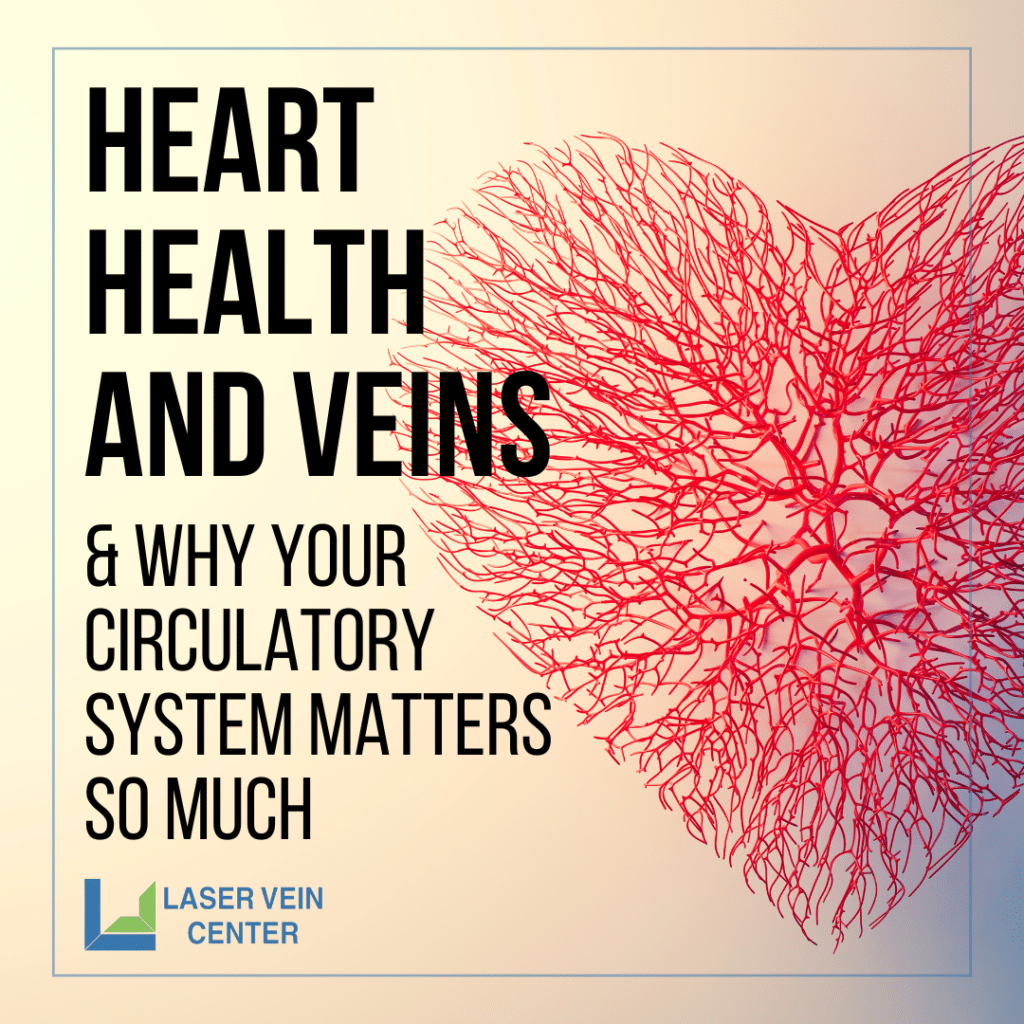
Your veins do more than just carry blood back to your heart—they play a critical role in your overall circulatory health. Healthy veins ensure that oxygen-depleted blood efficiently returns to the heart, supporting cardiovascular function and overall well-being. However, when veins weaken or develop problems, they can contribute to serious health issues, including varicose veins, chronic venous insufficiency (CVI), and an increased risk of blood clots.

As we recognize American Heart Month this February, it’s the perfect time to understand the connection between your veins and your heart and what you can do to protect both.
How Vein Health Affects Your Heart
The circulatory system consists of the heart, arteries, and veins working together to move blood throughout the body. While arteries transport oxygen-rich blood from the heart to the body, veins return oxygen-depleted blood back to the heart. To do this efficiently, veins contain one-way valves that prevent blood from pooling or flowing backward.
However, when these valves become weakened or damaged, blood struggles to move upward against gravity. This can lead to conditions such as:
- Varicose Veins – Enlarged, twisted veins caused by valve failure, leading to poor circulation, swelling, and discomfort.
- Chronic Venous Insufficiency (CVI) – A progressive condition where blood pools in the lower legs, causing pain, swelling, and skin discoloration.
- Deep Vein Thrombosis (DVT) – A serious condition where blood clots form in deep veins, potentially leading to life-threatening complications such as a pulmonary embolism.
When venous circulation is compromised, the heart must work harder to compensate. Over time, this added strain can contribute to higher blood pressure, increased cardiovascular risks, and even heart disease.
Warning Signs of Poor Vein Health
Recognizing the early signs of vein disease can help prevent more severe complications. If you experience any of the following symptoms, it may be time to seek medical evaluation:
✅ Swollen or aching legs – A feeling of heaviness, especially after long periods of standing or sitting.
✅ Varicose veins or spider veins – Visible, bulging veins that may cause discomfort or itching.
✅ Skin discoloration around the ankles – A sign of chronic venous insufficiency or worsening circulation issues.
✅ Persistent leg cramps or heaviness – May indicate sluggish blood flow and vein dysfunction.
✅ Leg ulcers or slow-healing wounds – A sign of advanced vein disease requiring immediate medical attention.
Ignoring these symptoms can worsen vein disease and increase cardiovascular strain, so early intervention is key.
Preventing Vein Disease and Protecting Your Heart
The good news is that many vein-related issues are preventable with lifestyle changes that promote healthy circulation and support cardiovascular function. Here’s how you can take proactive steps:
Stay Active
- Regular exercise, like walking, swimming, or cycling, promotes blood flow and strengthens veins.
- Leg exercises, such as calf raises and ankle rotations, help pump blood upward, reducing the risk of vein-related issues.
Eat a Heart-Healthy Diet
- Increase fiber intake to prevent constipation, which can put pressure on veins.
- Consume lean proteins and omega-3 fatty acids to reduce inflammation and improve circulation.
- Limit processed foods and excess salt, which contribute to water retention and swelling in the legs.
Wear Compression Stockings
- Compression therapy supports vein function, improves circulation, and reduces swelling in the legs.
- Medical-grade compression stockings are especially beneficial for individuals with varicose veins or CVI.
Avoid Prolonged Sitting or Standing
- Sitting for long periods (like at a desk or during travel) can slow circulation—try to stand and move every 30 minutes.
- If standing for extended periods, shift weight between legs and elevate your feet when possible.
Stay Hydrated
- Drinking plenty of water helps keep blood thin and flowing efficiently, reducing the risk of clot formation.
These simple lifestyle adjustments not only protect your vein health but also support overall heart function.
Treatment Options for Vein Disease
If you already experience varicose veins, spider veins, or symptoms of CVI, several minimally invasive treatments can restore proper circulation:
✔️ Sclerotherapy – A simple, non-surgical injection that collapses damaged veins and reroutes blood flow.
✔️ Laser Vein Therapy – Uses laser energy to target and close off problematic veins.
✔️ Radiofrequency or Endovenous Ablation – A highly effective procedure that seals off diseased veins using heat energy, improving circulation and reducing symptoms.
✔️ Microphlebectomy – A minimally invasive method of removing large, visible varicose veins through tiny incisions.
These treatments require little to no downtime and provide long-term relief from discomfort, swelling, and vein-related complications.
Take Control of Your Circulatory Health
Your veins and heart are intricately connected, and maintaining vein health is an essential part of cardiovascular care. If you’re experiencing symptoms of vein disease or want to take preventive measures, schedule a consultation with St. Louis Laser Veins today.
This Heart Month, make a commitment to prioritize your circulatory health—your heart (and your legs) will thank you! ❤️
